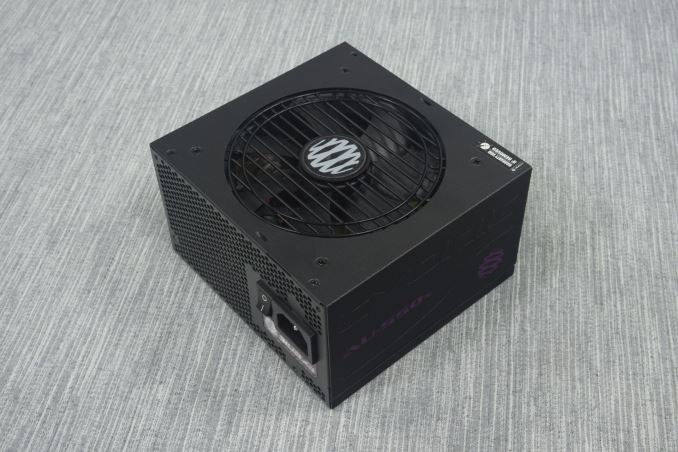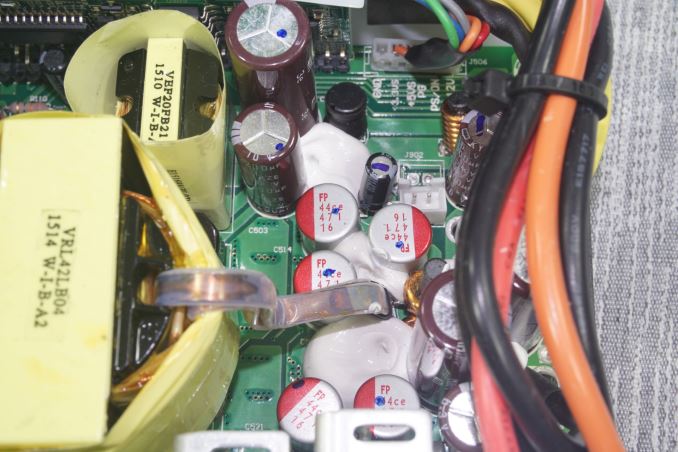The Cyonic AU-550x PSU Review
by E. Fylladitakis on August 17, 2015 8:00 AM EST- Posted in
- Cases/Cooling/PSUs
- Seasonic
- PSUs
- 550W
- Cyonic
Conclusion
In our humble opinion, Cyonic started off the right foot as a company. Instead of starting with very high power products, like many other companies did before, they opted to focus on just a few high performance 450-650 Watt PSUs. This power range is where the needs of the vast majority of PC users lie. A typical home/office PC would hardly ever reach a demand greater than 200 Watts and even a good gaming system with a single GPU should not require more than 400-450 Watts at peak power. As all switching PSUs operate best at about 50% load, the Cyonic models are ideal for such systems.
The overall performance of the AU-550x came as a little surprise to us. When we saw the minimal heatsinks and the modified platform, we initially expected it to perform worse than the Seasonic G-series model. True enough, the thermal performance of the AU-550x is slightly worse and it does get a little warmer when it is heavily stressed. However, to our surprise and despite the presence of the secondary vertical PCB and all the losses associated with the extra connections/cables, the Cyonic AU-550x is still a little more efficient than the standard platform it is based on. It also resists very high temperatures and can still deliver very good performance under very harsh conditions. The higher efficiency combats the heatsink mass reduction and allows the Cyonic AU-550x to maintain very low noise levels. The company could make the thermal control of the PSU more aggressive, with the fan speeding up faster and forcing it to maintain lower internal temperatures, but opted for excellent acoustics performance instead. Considering the very high quality components that this PSU is made of, we believe that is was a good trade-off.
When it comes to electrical performance, we were bewildered to see the massive difference between the minor voltage lines and the main 12V line. We had to repeat our tests several times just to make sure. The filtering of the 3.3V/5V lines is one of the best that we have ever seen, if not the best, with our instruments hardly capable of recording any ripple at all. On the other hand, the 12V line is well filtered, but nowhere near as perfectly as the minor voltage lines. The presence of very high quality capacitors throughout the design makes this even stranger, as it implies that the ripple does not come from the mediocre capabilities of an average capacitor. Nevertheless, even the maximum ripple that the 12 V line displayed was half that of the ATX design limit, so we should stress that this is not really a problem, just a peculiar characteristic of this particular PSU.
In summary, the Cyonic AU-550x does very well and we feel that the newly founded company started off with some very interesting products that are targeted at a wide audience. With a retail price of $90 plus shipping, the Cyonic AU-550x is well-priced as well. Most quality 80Plus Gold certified 550 Watts PSUs are currently retailing for $80-120, so that does not make the Cyonic AU-550x an astonishing deal but, considering its performance, quality and design, it certainly earns our recommendation.












30 Comments
View All Comments
Samus - Monday, August 17, 2015 - link
I agree! Some vendors have turned pretty crappy designs from questionable OEMs into decent products. Look at OCZ psu's after they purchased PCP&C. Most of them were then built by FSP and let's face it FSP made some real crap back in the day...a lot of the same designs were used by XFX but the OCZ models were consistently better and the warranty was much more honorable.YoloPascual - Monday, August 17, 2015 - link
It still better than buying the brand name. You won't even need to think about the warranty when you have a really good psu. And who wants to deal with warranty claims?Samus - Monday, August 17, 2015 - link
True. But support is everything with technology.Years ago, PC Power & Cooling offered a one-time rewiring of the PSU free of charge if the end-user covered shipping and handling. I took them up on this in 2008 with a 750 Quad and it cost $18 total ($8 to ship it to them, $10 for them to process and ship it back.)
In exchange, I was returned a completely remapped cable layout to fit my case exactly. This is before modular PSU's were really common place, but even modular PSU's either have too short or too long of cables.
I don't believe any other OEM's offer this kind of service anymore. Very unfortunate. But there are other perks OEM's offer other than warranty, such as color coding components to other products they make, and a verified hardware (quality assurance) guarantee.
dwatterworth - Monday, August 17, 2015 - link
Stating the power output of the unit as 'Mediocre' in conjunction with the maximum fan RPM to define it's potential profile is probably not the best description. Wording does make a difference, pointing in this case that the unit should be supplying much higher levels of power and is sub-par; something not usually associated with any seasonic unit other than their less than average for Seasonic TFX units.yt2005 - Monday, August 17, 2015 - link
Good testing as always, but the article reads like it was written by someone who isn't a native-level speaker of English; the writing feels stilted at times, and that made it difficult to read.Peichen - Monday, August 17, 2015 - link
Does Emmanouil Fylladitakis sounds American/British to you?DCide - Monday, August 17, 2015 - link
Exactly what I was thinking. I'm sure I couldn't even do him the courtesy of pronouncing his name right, so I have to give him a pass on an incomplete sentence here or there.Samus - Monday, August 17, 2015 - link
His background is electronics not English. The odds of an English major putting together a ripple chart are pretty weak so I'll take the review how it is :) even johnnyguru has some skitch here and there, and sometimes I think he's been drinking but they're still great reviews!ImSpartacus - Monday, August 17, 2015 - link
Good to see a review for a psu that I might buy. Nice job.romrunning - Monday, August 17, 2015 - link
Kudos for reviewing a PSU with a lower power output (450-550W) than the higher output ones!This is exactly what I was looking for to run a single-GPU system.